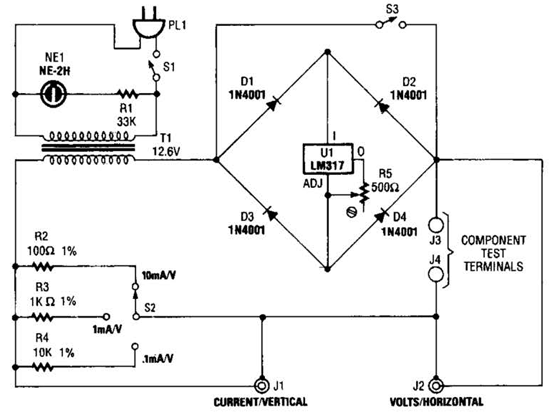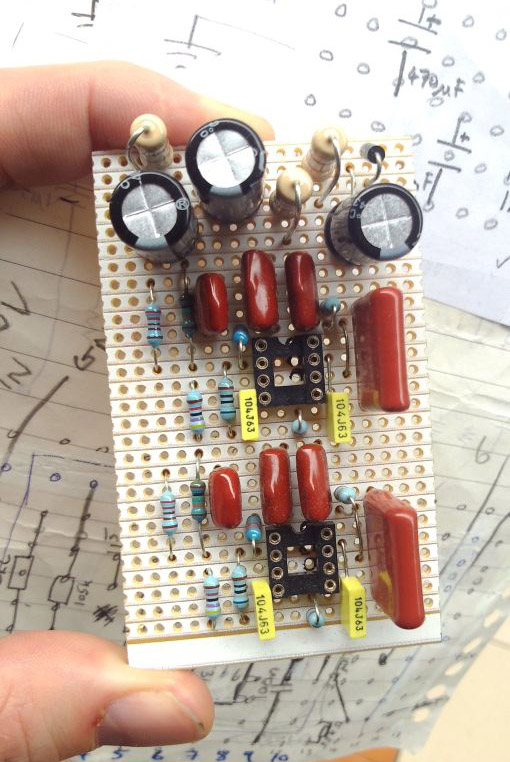Capacitance and Uses of Capacitors
| unpolarised capacitor symbol |
| polarised capacitor symbol |
Capacitance
Capacitance (symbol C) is a measure of a capacitor's ability to store charge. A large capacitance means that more charge can be stored. Capacitance is measured in farads, symbol F. However 1F is very large, so prefixes (multipliers) are used to show the smaller values:- µ (micro) means 10-6 (millionth), so 1000000µF = 1F
- n (nano) means 10-9 (thousand-millionth), so 1000nF = 1µF
- p (pico) means 10-12 (million-millionth), so 1000pF = 1nF
Charge and Energy Stored
The amount of charge (symbol Q) stored by a capacitor is given by:| Charge, Q = C × V | where: | Q = charge in coulombs (C) C = capacitance in farads (F) V = voltage in volts (V) |
When they store charge, capacitors are also storing energy:
| Energy, E = ½QV = ½CV² where E = energy in joules (J). |
Note that capacitors return their stored energy to the circuit. They do not 'use up' electrical energy by converting it to heat as a resistor does. The energy stored by a capacitor is much smaller than the energy stored by a battery so they cannot be used as a practical source of energy for most purposes.
Capacitive Reactance Xc
Capacitive reactance (symbol Xc) is a measure of a capacitor's opposition to AC (alternating current). Like resistance it is measured in ohms,| Capacitive reactance, Xc = | 1 | where: | Xc = reactance in ohms ( f = frequency in hertz (Hz) C = capacitance in farads (F) |
| 2 |
The reactance Xc is large at low frequencies and small at high frequencies. For steady DC which is zero frequency, Xc is infinite (total opposition), hence the rule that capacitors pass AC but block DC.
For example a 1µF capacitor has a reactance of 3.2k for a 50Hz signal, but when the frequency is higher at 10kHz its reactance is only 16
for a 50Hz signal, but when the frequency is higher at 10kHz its reactance is only 16 .
.
Note: the symbol Xc is used to distinguish capacitative reactance from inductive reactance XL which is a property of inductors. The distinction is important because XL increases with frequency (the opposite of Xc) and if both XL and Xc are present in a circuit the combined reactance (X) is the difference between them. For further information please see the page on Impedance.
Capacitors in Series and Parallel
| Combined capacitance (C) of capacitors connected in series: | 1 | = | 1 | + | 1 | + | 1 | + ... |
| C | C1 | C2 | C3 |
| Combined capacitance (C) of capacitors connected in parallel: | C = C1 + C2 + C3 + ... |
Two or more capacitors are rarely deliberately connected in series in real circuits, but it can be useful to connect capacitors in parallel to obtain a very large capacitance, for example to smooth a power supply.
Note that these equations are the opposite way round for resistors in series and parallel.
Charging a capacitor
Charging current, I = (Vs - Vc) / R (note that Vc is increasing)
At first Vc = 0V so the initial current, Io = Vs / R
Vc increases as soon as charge (Q) starts to build up (Vc = Q/C), this reduces the voltage across the resistor and therefore reduces the charging current. This means that the rate of charging becomes progressively slower.
| time constant = R × C | where: | time constant is in seconds (s) R = resistance in ohms ( C = capacitance in farads (F) |
For example:
If R = 47k and C = 22µF, then the time constant, RC = 47k
and C = 22µF, then the time constant, RC = 47k × 22µF = 1.0s.
× 22µF = 1.0s.
If R = 33k and C = 1µF, then the time constant, RC = 33k
and C = 1µF, then the time constant, RC = 33k × 1µF = 33ms.
× 1µF = 33ms.
If R = 47k
If R = 33k
A large time constant means the capacitor charges slowly. Note that the time constant is a property of the circuit containing the capacitance and resistance, it is not a property of a capacitor alone.
| Graphs showing the current and voltage for a capacitor charging time constant = RC |
After each time constant the current falls by 1/e (about 1/3). After 5 time constants (5RC) the current has fallen to less than 1% of its initial value and we can reasonably say that the capacitor is fully charged, but in fact the capacitor takes for ever to charge fully!
|
After 5 time constants (5RC) the capacitor is almost fully charged with its voltage almost equal to the supply voltage. We can reasonably say that the capacitor is fully charged after 5RC, although really charging continues for ever (or until the circuit is changed).
Discharging a capacitor
| Graphs showing the current and voltage for a capacitor discharging time constant = RC |
The top graph shows how the current (I) decreases as the capacitor discharges. The initial current (Io) is determined by the initial voltage across the capacitor (Vo) and resistance (R):
Initial current, Io = Vo / R.
Note that the current graphs are the same shape for both charging and discharging a capacitor. This type of graph is an example of exponential decay.
|
At first the current is large because the voltage is large, so charge is lost quickly and the voltage decreases rapidly. As charge is lost the voltage is reduced making the current smaller so the rate of discharging becomes progressively slower.
After 5 time constants (5RC) the voltage across the capacitor is almost zero and we can reasonably say that the capacitor is fully discharged, although really discharging continues for ever (or until the circuit is changed).
Uses of Capacitors
Capacitors are used for several purposes:- Timing - for example with a 555 timer IC controlling the charging and discharging.
- Smoothing - for example in a power supply.
- Coupling - for example between stages of an audio system and to connect a loudspeaker.
- Filtering - for example in the tone control of an audio system.
- Tuning - for example in a radio system.
- Storing energy - for example in a camera flash circuit.
Capacitor Coupling (CR-coupling)
The precise behaviour of a capacitor coupling is determined by its time constant (RC). Note that the resistance (R) may be inside the next circuit section rather than a separate resistor.
For successful capacitor coupling in an audio system the signals must pass through with little or no distortion. This is achieved if the time constant (RC) is larger than the time period (T) of the lowest frequency audio signals required (typically 20Hz, T = 50ms).
Output when RC >> T
When the time constant is much larger than the time period of the input signal the capacitor does not have sufficient time to significantly charge or discharge, so the signal passes through with negligible distortion.
When the time constant is much larger than the time period of the input signal the capacitor does not have sufficient time to significantly charge or discharge, so the signal passes through with negligible distortion.
Output when RC = T
When the time constant is equal to the time period you can see that the capacitor has time to partly charge and discharge before the signal changes. As a result there is significant distortion of the signal as it passes through the CR-coupling. Notice how the sudden changes of the input signal pass straight through the capacitor to the output.
When the time constant is equal to the time period you can see that the capacitor has time to partly charge and discharge before the signal changes. As a result there is significant distortion of the signal as it passes through the CR-coupling. Notice how the sudden changes of the input signal pass straight through the capacitor to the output.
Output when RC << T
When the time constant is much smaller than the time period the capacitor has time to fully charge or discharge after each sudden change in the input signal. Effectively only the sudden changes pass through to the output and they appear as 'spikes', alternately positive and negative. This can be useful in a system which must detect when a signal changes suddenly, but must ignore slow changes.
When the time constant is much smaller than the time period the capacitor has time to fully charge or discharge after each sudden change in the input signal. Effectively only the sudden changes pass through to the output and they appear as 'spikes', alternately positive and negative. This can be useful in a system which must detect when a signal changes suddenly, but must ignore slow changes.



Comments
Post a Comment